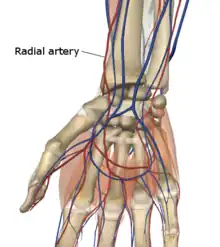Radial artery puncture
Radial artery puncture is a medical procedure performed to obtain a sample of arterial blood for gas analysis.[1] A needle is inserted into the radial artery and spontaneously fills with blood. The syringe is either prepacked with a small amount of heparin to prevent coagulation, or must be heparinised, by drawing up a small amount of heparin and squirting it out again.. The available evidence suggests that the use of local anaesthesia, prior to arterial puncture, does not reduce the perceived pain of the procedure.[2]

The right radial artery.
References
- Collins, Kevin P.; Russian, Christopher J.; Gonzales, Joshua F. (2016). "Teaching Health Care Students the Radial Arterial Puncture Procedure". Journal of Allied Health. 45 (4): 283–288. ISSN 1945-404X. PMID 27915362. Retrieved 7 March 2021.
- Wade, Ryckie G.; Crawfurd, Jim; Wade, Donna; Holland, Richard (November 2015). "Radial artery blood gas sampling: a randomized controlled trial of lidocaine local anesthesia: RCT of lidocaine for arterial puncture". Journal of Evidence-Based Medicine. 8 (4): 185–191. doi:10.1111/jebm.12177. PMID 26779697. S2CID 23384432.
This article is issued from Wikipedia. The text is licensed under Creative Commons - Attribution - Sharealike. Additional terms may apply for the media files.